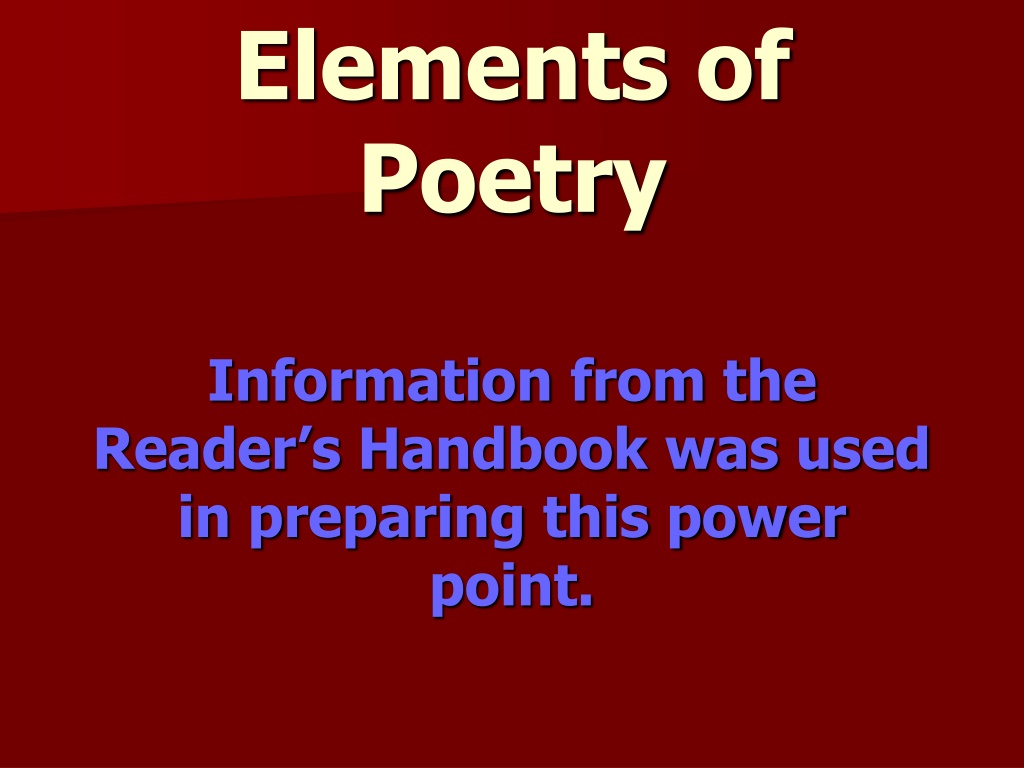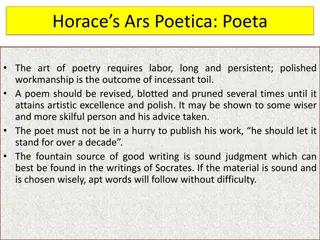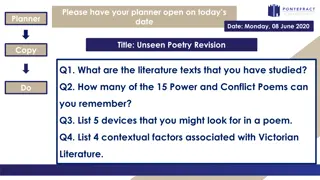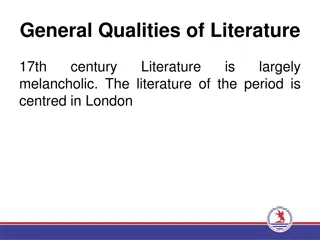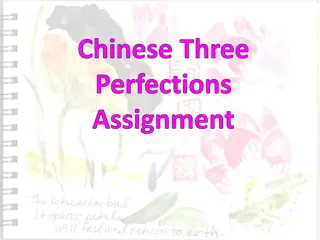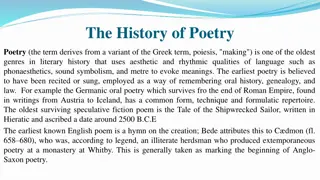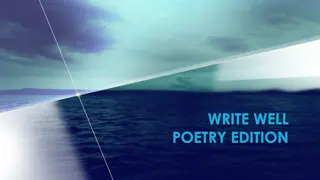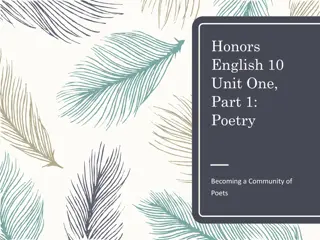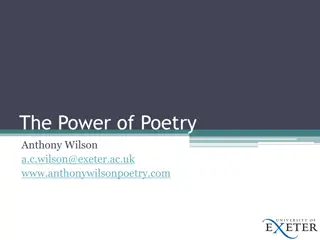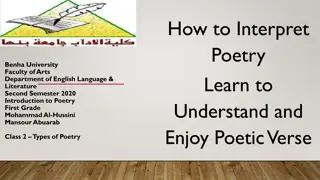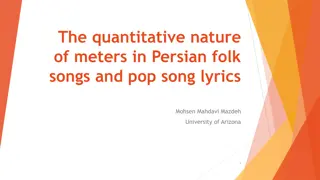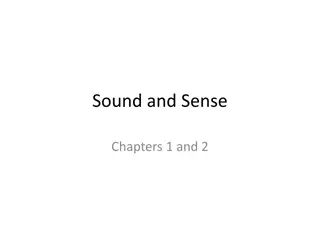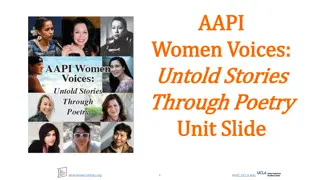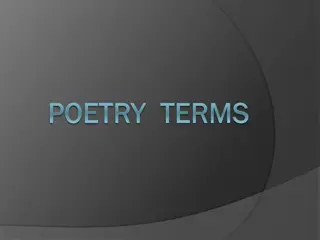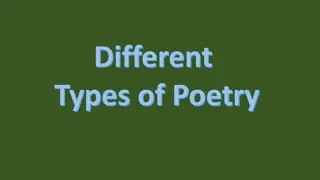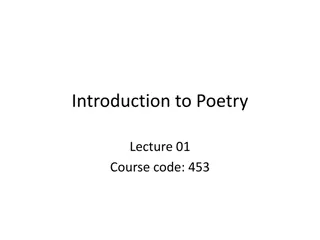Understanding Poetry: Elements and Examples
Poetry conveys ideas and feelings through carefully selected words and techniques. To interpret a poem, one must analyze elements like alliteration, allusion, hyperbole, figurative language, and more. Explore the beauty of free verse and delve into a Langston Hughes poem for a deeper understanding of poetic expression.
Download Presentation

Please find below an Image/Link to download the presentation.
The content on the website is provided AS IS for your information and personal use only. It may not be sold, licensed, or shared on other websites without obtaining consent from the author. Download presentation by click this link. If you encounter any issues during the download, it is possible that the publisher has removed the file from their server.
E N D
Presentation Transcript
Elements of Poetry Information from the Reader s Handbook was used in preparing this power point.
Poems Convey an idea or a feeling through carefully selected words and phrases. To unlock the meaning of a poem, you have to consider every word that the poet has chosen. You also need to be familiar with different techniques and styles that a poet may use.
Poetry elements include Alliteration Allusion Hyperbole Figurative Language Free Verse Idiom Imagery Lyric Poem Metaphor Mood / Tone and Voice Narrative Poem Onomatopoeia Personification Repetition Rhyme Rhyme Scheme Rhythm Simile Stanza Symbol
Alliteration Alliteration is the repetition of the same consonant sound at the beginning of several words of the line of poetry or a sentence. Example Sally sells seashells by the seashore Example The sleek, silver snake slithered away.
Allusion An allusion is a reference to something with which the reader is likely to be familiar, such as a person, place or event from history or literature.
Hyperbole A hyperbole is an exaggeration or the obvious stretching of the truth. Example Mrs. Reynolds caught a catfish three feet long. Example I have a ton of homework!
Figurative Language Figurative language is made up of all the tools that a poet uses to create a special effect or feeling. It includes metaphor, simile, alliteration, personification and onomatopoeia.
Free Verse Free verse is poetry written without a regular rhyme scheme, meter, or form.
April Rain Song by Langston Hughes Let the rain kiss you. Let the rain beat upon your head with silver liquid drops. Let the rain sing you a lullaby. The rain makes still pools on the sidewalk. The rain makes running pools in the gutter. The rain plays a little sleep-song on our roof at night And I love the rain.
Imagery Imagery is language that appeals to the five senses touch, taste, smell, hearing and sight. Example The sweet fragrance of the honeysuckle eased my worries and relaxed my mind. Example The butterfly floated on the summer breeze and landed on the softness of a velvety rose blossom.
Lyric Poem A lyric poem is a short poem that directly expresses the poet s thoughts and emotions in a musical way.
A Red Red Rose by Robert Burns As fair art thou, my bonie lass, So deep in luve am I, And I will luve thee still, my dear, Till a the seas gang dry. O my luve is like a red, red rose, That s newly sprung in June. O my luve is like the melodie, That s sweetly play d in tune.
Metaphor A metaphor is a direct comparison between two unlike things, It does not use the words like or as. Example Her eyes were soft blue pools. Example The stars were diamonds in the vast blue sky.
Mood Mood is the feeling created in the reader by the poem or story. Words, phrases repetition, rhyme, and exaggeration all work together to create mood.
Narrative Poem A narrative poem is a poem that tells a story. Narrative poems usually have all of the elments you would find in a short story: character, setting, conflict, and plot.
Onomatopoeia Onomatopoeia is the use of words that sound like the noises they describe. Examples: pop, click, boom, sizzle, zing
Personification Personification is a type of figurative language in which poets give an animal, object, or idea human qualities, such as the ability to hear, feel, talk, and make decisions. Example The story of the Three Little Pigs Example The sun cradled me with its warm rays.
Repetition Repetition means to repeat something. It is the use of any element of language a sound, word, phrase, or sentence = more than once. Repetition holds a poem together with a pattern readers come to expect. Repetition creates suspense and adds humor or music. Repetition emphasizes meaning.
Rhyme Rhyme is the repetition of similar sounds. End rhyme is the repetition of similar sounds that come at the ends of lines of poetry. Internal rhyme occurs within a line when two words have similar sounds.
Rhyme Scheme Rhyme scheme is a repeated regular pattern of rhymes usually found at the end of lines in a poem.
Example of Rhyme Scheme Adventures of Isabel by Ogden Nash The bear said, Isabel, glad to meet you, How do Isabel, now I ll eat you! Isbel met an enormous bear, Isabel, Isabel, didn t care; The bear was hungry, the bear was ravenous, The bear s big mouth was cruel and cavernous. What is the rhyme scheme of this poem?
Rhythm Rhythm is the musical quality created by a pattern of beats or a series of stressed and unstressed syllables.
First Fig by Edna St. Vincent Millay My candle burns at both ends; It will not last the night; But ah, my foes, and oh, my friends It gives a lovely light!
Simile A smile is a comparison between two unlike things using the words like or as. Example His feet were like boats. Example Her tears were as droplets of rain.
Stanza A stanza is a group of lines in a poem set off by blank lines. It usually develops one idea. A stanza in a poem is something like a paragraph in a prose. Stanzas are important because they give a poem shape on the page and help create the poem s meaning. Stanza is an Italian word that means stopping place or place to rest.
Symbol A symbol is something that stands for something else. Examples a blue ribbon or gold medal is a symbol for first place. The Statue of Liberty is a symbol of freedom. The crown is a symbol of a king s power.
Tone and Voice Tone is the attitude the writer takes toward the audience, the subject, or a character. The voice, or speaker, is the character or perspective that is taken on by a writer or poet. Often the voice is not identified by name.
Idioms Are words, phrases or expressions that cannot be taken literally. In other words when used in everyday language, they have a meaning other than the basic one you would find in a dictionary. It is a phrase that sounds idiotic.
Examples of Idioms I m on top of the world. That outfit cost me an arm and a leg. Don t cut corners on this project. By doing this, we re killing two birds with one stone. I m caught between a rock and a hard place. It s raining cats and dogs.
Clichs Is an expression or idea of an artistic work that has been overused to the point of losing its original meaning. Examples: Time well spent scared to death A waste of time all s well that ends well Fit as a fiddle the writing on the wall
